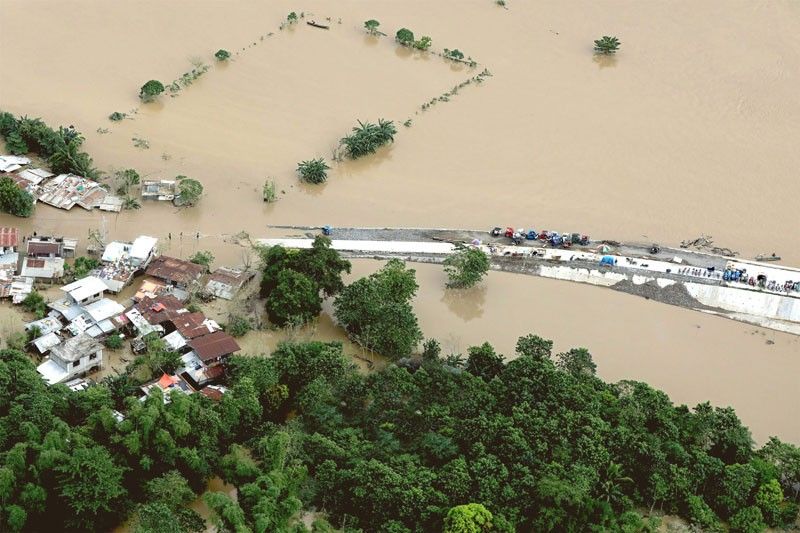More infrastructure to prevent flooding? DPWH says ‘engineering’ part of solution

MANILA, Philippines — Flood control may again be getting one of the largest shares in the proposed Department of Public Works and Highways 2024 budget, but House lawmakers on Thursday appeared unconvinced that pouring more money into infrastructure could solve flooding.
Makabayan lawmakers Rep. Raoul Manuel (Kabataan Partylist) Rep. France Castro (ACT Teachers) pointed out that past flood control and management initiatives remain inefficient as several areas have even become more prone to flooding in recent years.
For 2024, a whopping P215.643 billion has been allocated for flood mitigation facilities. This is a nearly 20% increase from 2023 (P182 billion) and represents more than a quarter of the proposed 2024 budget for the DPWH (P822 billion).
“We are boasting that this is climate change expenditure, but it seems like we are just using it to bloat the figures we report internationally,” Manuel said in a mix of English and Filipino.
DPWH Secretary Manuel Bonoan said that President Ferdinand Marcos Jr. has instructed his officials to look for “permanent instructions” to flooding, one of which includes the construction of more water-impounding facilities.
The DPWH chief added that the department is also looking into impounding areas in river basins, reservoirs, flood control and water supply as possible long-term solutions to flooding.
“All these things are being laid out now for implementation. There are 18 major river basins in the country and there are many projects (ongoing) for flood control,” Bonoan said.
During Castor's interpellation, she asked Bonoan whether past flood projects can be considered "a success." In response, Bonoan said that there are several factors affecting flood control, with the phenomenon of climate change posing "a big challenge."
“Our job is on the engineering part, but other components have to be considered for a holistic view of flood control. The engineering part will certainly do something to mitigate the problem of flooding, but there should be more. We should look at the environmental and social issues,” Bonoan added.
Meanwhile, Rep. Edgar Chatto, House climate change panel chair, also urged the DPWH to coordinate with the National Irrigation Administration to ensure that water management ends up benefiting farmers affected by climate change.
Bonoan said that the DPWH in 2023 has started working more closely with the NIA for the efficient utilization of water resources.
Early this year, Marcos tasked both agencies to implement high-impact irrigation projects, with the NIA targeting to complete P200 billion worth of dam projects a year.
Bonoan also said during the budget briefing that dams can serve as “multipurpose facilities” that control flooding and ensure efficient water supply.
At this, Castro cautioned, however, that the construction of dams should not violate human rights of persons living in areas where dams will be constructed.
“That is the primordial consideration. Don’t violate their human rights. Don’t take away their livelihood,” Castro added.
Senators flag flood budget
According to Sen. Joel Villanueva in a press briefing in August, the president himself has requested help in going after officials involved in irregularities in flood control projects.
Villanueva filed a Senate resolution seeking to investigate the "perennial problem" of flooding in Metro Manila.
Senators also flagged the large allocation for flood control projects during the DPWH’s budget briefing at the Senate in August.
The DPWH’s proposed budget for flood management is also six times larger than funding for school buildings, 16 times larger than hospitals, and eight times larger than calamity funds, Sen. Grace Poe pointed out.
Sen. Chiz Escudero also pointed out that the government’s economic roadmap, Medium-Term Philippine Development Plan 2023-2028, "barely mentions flood control as a development imperative."
Recent flooding in Central Luzon should not be used as a "lame excuse to inundate the 2024 national budget with flood control projects because Region III will only get around P10 billion plus or 4% of the total budget,” Escudero said.
Up to 134 barangays in 12 towns and two cities in Bulacan were submerged in floods after a bout of heavy rains brought by Super Typhoon Egay in July.
In just three decades, approximately 6.8 million people in the Philippines may face inundation due to rising sea levels, according to a study by Climate Central.
RELATED: In 30 years, rising seas will threaten Philippine cities, towns home to 6.8 million
The Philippines also has the “highest disaster risk” among all countries in the World Risk Index 2022, higher than India and Indonesia. — with reports by Gaea Katreena Cabico
- Latest
- Trending
































